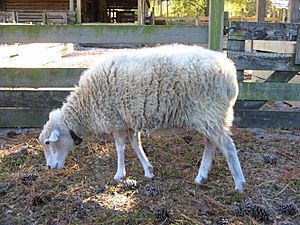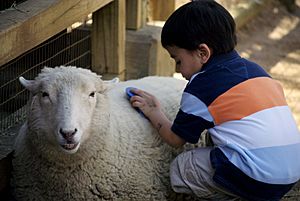Gulf Coast Native sheep facts for kids
The Gulf Coast Native is a special type of sheep. It comes from the U.S. states along the Gulf Coast. People sometimes call them Louisiana Scrub, Pineywoods Native, or just Gulf Coast sheep. This breed is a mix of many different sheep that lived in the Southern United States when Europeans first settled there. Today, the Gulf Coast Native is a very rare breed. However, it is very important because it can live well in the hot, wet weather of the Gulf Coast.
Contents
History of Gulf Coast Native Sheep
The story of Gulf Coast Native sheep began a long time ago. Their ancestors were Churra sheep brought to America by the Spanish in the 1400s. Later, these Criollo-type sheep mixed with British and French sheep breeds. Some of them might even have a little bit of Tunis sheep in their family tree.
How Gulf Coast Sheep Adapted
For many years, thousands of Gulf Coast sheep roamed freely in the South. They lived on open pastures and were only gathered up sometimes. Back then, there were no modern ways to care for sheep. So, these sheep had to get used to the Southern climate on their own. Over many decades, they became very strong and resistant to the hot and humid conditions. Because of this, different types of the breed appeared in places like Louisiana, Texas, and Florida.
Decline of the Breed
By the mid-1900s, Gulf Coast Native sheep provided almost all the wool for the Southern United States. There were hundreds of thousands of them. But after World War II, new medicines for worms and other farming tools became common. This meant farmers could bring in newer sheep breeds that produced more wool or meat. Because of this, the number of Gulf Coast Native sheep quickly went down. Since 1994, there has been a group dedicated to protecting these sheep.
Protecting Gulf Coast Native Sheep
Today, the American Livestock Breeds Conservancy says Gulf Coast Native sheep are "critical." This means they are very rare and need help to survive. They are also part of Slow Food USA's Ark of Taste, which helps protect special foods and breeds. Some universities, like the University of Florida and Louisiana State University, have research flocks. The USDA also keeps some for research. Even Zoo Atlanta has a group of these sheep to help protect them.
Characteristics of Gulf Coast Native Sheep
Gulf Coast Natives are small sheep with light bones. Female sheep, called ewes, usually weigh no more than 180 pounds. Male sheep, called rams, weigh up to 200 pounds. They can be even smaller if they live on poor land. Both male and female sheep can have horns or be polled (meaning they don't have horns).
Wool and Appearance
Even though they are mostly raised for meat, Gulf Coast Natives have light wool. This wool might have some hair in it and is about 2.5 to 4 inches long. It is usually white, but sometimes it can be brown, black, or spotted. A special feature of Gulf Coast sheep is that they do not have wool on their faces, bellies, or legs. This helps them stay cool in the hot Southern weather.
Resistance to Diseases
The most amazing thing about Gulf Coast Native sheep is how well they resist diseases and parasites. These problems are very common for sheep in hot and wet places. Compared to other sheep breeds, Gulf Coast Natives are especially good at fighting off foot rot and a dangerous stomach worm called Haemonchus contortus. Both of these are more common in warmer climates.



